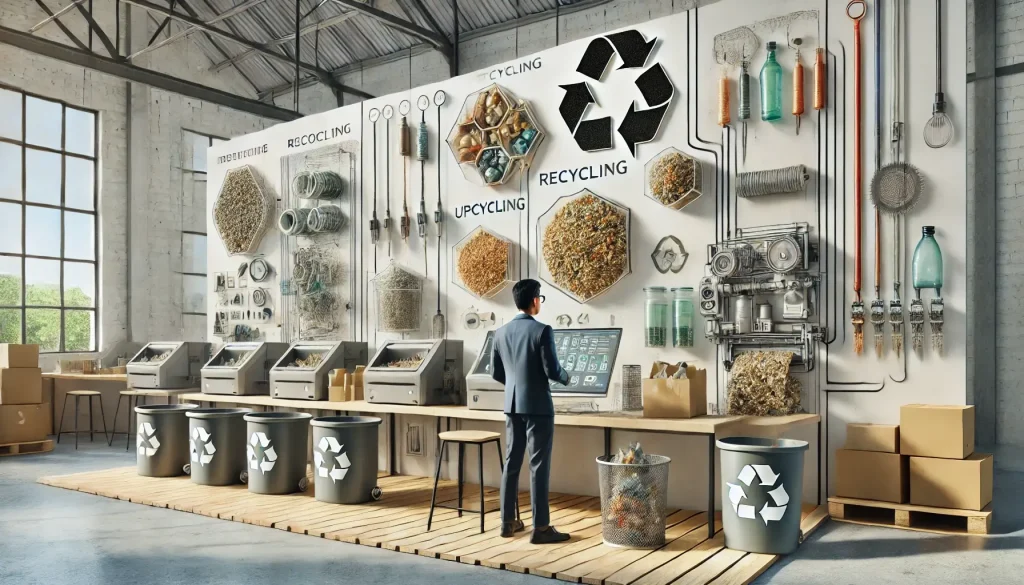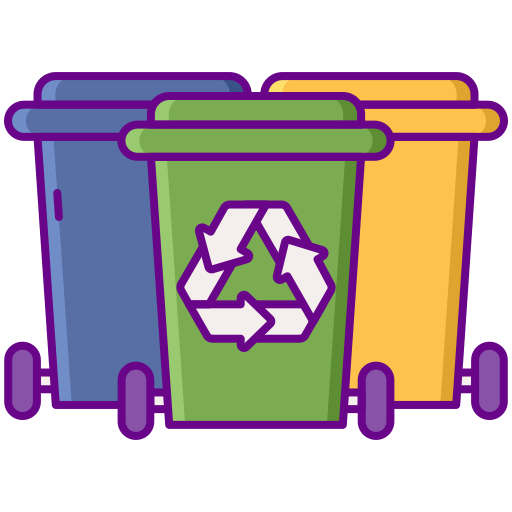Num mundo em que os desafios ambientais exigem soluções urgentes, a capacidade de conservar os nossos recursos é mais importante do que nunca. A reciclagem surgiu como uma ferramenta poderosa na busca pela redução de resíduos, recuperação de materiais valiosos e minimização de nossa pegada ecológica. Na Eu Setor, nos dedicamos a ser pioneiros em práticas inovadoras de reciclagem que não apenas transformam resíduos em novos recursos, mas também criam um futuro sustentável para as próximas gerações.

Índice
O imperativo de conservar através da reciclagem
Reciclar não é simplesmente eliminar os resíduos - é repensar fundamentalmente a nossa relação com os materiais. Ao abraçar a reciclagem, nós ativamente conservar recursos, reduzir a poluição e avançar para uma economia circular em que os produtos são continuamente reutilizados em vez de serem deitados fora.
Benefícios ambientais da conservação
- Redução de resíduos: A reciclagem reduz a quantidade de resíduos enviados para aterros e incineradoras. Ao desviar os resíduos destas instalações, nós conservar espaço em aterros e reduzir a produção de emissões nocivas.
- Eficiência de recursos: A reciclagem transforma materiais usados em novos produtos, diminuindo assim a necessidade de extração de matérias-primas. Este processo ajuda conservar os nossos recursos naturais finitos, como a água, os minerais e os combustíveis fósseis.
- Poupança de energia: O fabrico de produtos a partir de materiais reciclados requer normalmente menos energia do que a produção a partir de recursos virgens. Esta eficiência energética não só conserva mas também reduz as emissões de gases com efeito de estufa, contribuindo para a atenuação das alterações climáticas.
Vantagens económicas e sociais
- Poupança de custos: As empresas que investem em estratégias de reciclagem e redução de resíduos registam frequentemente poupanças de custos significativas na produção, gestão de resíduos e aquisição de recursos. Estas poupanças podem ser reinvestidas em outras iniciativas sustentáveis, criando um ciclo virtuoso que ajuda conservar recursos financeiros e materiais.
- Criação de emprego: A indústria da reciclagem gera oportunidades de emprego nos sectores da recolha, processamento e fabrico. Ao apoiar programas de reciclagem, ajudamos conservar as economias locais e estimular o crescimento sustentável do emprego.
- Saúde e bem-estar da comunidade: A redução dos resíduos e a conservação dos recursos conduzem a ambientes mais limpos e a comunidades mais saudáveis. Menos aterros e menos poluição melhoram diretamente a qualidade do ar e da água, melhorando a saúde pública em geral.
Técnicas de reciclagem inovadoras para a conservação de recursos
Para realmente conservar a reciclagem moderna deve ir além dos métodos tradicionais. Aqui, exploramos algumas das técnicas de reciclagem mais inovadoras que estão a remodelar a gestão de resíduos e a conservação de recursos.
1. Triagem e recuperação avançadas de materiais
As modernas instalações de reciclagem utilizam atualmente tecnologias de ponta para separar e processar os resíduos de forma mais eficiente:
- Sensores IoT e análise de dados: Os sensores inteligentes instalados nos contentores de reciclagem e nos centros de processamento recolhem dados em tempo real sobre os fluxos de resíduos. Esta abordagem baseada em dados assegura uma triagem precisa, permitindo às instalações conservar materiais valiosos, reduzindo a contaminação e aumentando a pureza dos produtos reciclados.
- Sistemas de triagem automatizados: A robótica e as linhas de triagem alimentadas por IA diferenciam rapidamente entre vários tipos de materiais - como plásticos, metais e papel - assegurando que cada material é processado adequadamente. Esta automatização ajuda conservar recursos, maximizando as taxas de recuperação e reduzindo os erros manuais.
- Reciclagem de produtos químicos: Técnicas inovadoras de reciclagem química decompõem os plásticos complexos nos seus componentes básicos, que podem depois ser transformados em materiais de alta qualidade. Este método alarga a possibilidade de reciclagem de materiais que anteriormente eram considerados não recicláveis, permitindo assim conservação mais recursos.
2. Economia circular e sistemas de ciclo fechado
A economia circular é a espinha dorsal da conservação dos recursos. Ao conceberem produtos para longevidade e reciclagem, as empresas podem criar um sistema de ciclo fechado em que os materiais são continuamente reutilizados.
- Redesenho de produtos para reciclagem: Os engenheiros estão cada vez mais a conceber produtos tendo em conta o processo de reciclagem em fim de vida. Esta abordagem proactiva garante que os artigos podem ser facilmente desmontados e reciclados, ajudando a conservar materiais ao longo do ciclo de vida do produto.
- Fabrico em circuito fechado: Nos sistemas de ciclo fechado, os materiais reciclados são reintegrados nos ciclos de produção, reduzindo a necessidade de novas matérias-primas. Este ciclo de reutilização contínua é fundamental para conservar recursos e promover a sustentabilidade a longo prazo.
- Remanufacturação: O refabrico envolve o restauro de produtos usados para um estado "como novo" através de uma renovação sistemática. Este processo não só conserva recursos ao prolongar a vida útil do produto, mas também minimiza os resíduos ao reutilizar componentes.
3. Inovações digitais e transparência
A tecnologia desempenha um papel fundamental para tornar os processos de reciclagem mais eficientes e transparentes, o que, por sua vez, ajuda conservar recursos:
- Tecnologia Blockchain: Ao utilizar blockchain para rastrear materiais reciclados, as empresas podem garantir que cada etapa do processo de reciclagem seja transparente e verificável. Esta transparência aumenta a responsabilidade e incentiva a adesão a normas ecológicas.
- Aplicações móveis e plataformas digitais: Estas ferramentas ligam os consumidores aos serviços de reciclagem, proporcionando um acesso fácil a diretrizes e incentivos. Um maior envolvimento digital promove taxas de reciclagem mais elevadas e ajuda conservar recursos, fazendo da reciclagem uma parte integrante da vida quotidiana.
- IA e aprendizagem automática: A análise preditiva e os sistemas de triagem baseados em IA optimizam as operações de reciclagem, assegurando que a quantidade máxima de material é recuperada e reutilizada. Estas tecnologias não só melhoram a eficiência, como também ajudam a conservar energia e reduzir os custos operacionais.
Estratégias para maximizar os benefícios ambientais
Para efetivamente conservar recursos através da reciclagem, as organizações e as comunidades devem adotar estratégias abrangentes que integrem tecnologia, educação e política.
1. Melhoria das infra-estruturas
A construção e a manutenção de instalações de reciclagem modernas, equipadas com tecnologia avançada, são cruciais para a conservação efectiva dos recursos.
- Investimento em instalações modernas: A atualização dos centros de reciclagem com maquinaria de ponta garante taxas de recuperação mais elevadas e materiais reciclados de melhor qualidade.
- Integração de tecnologias inteligentes: A implementação de soluções de IoT, IA e blockchain em instalações de reciclagem otimiza as operações e conserva tanto de materiais como de energia.
- Centros Comunitários de Reciclagem: A criação de centros de reciclagem locais facilita a participação das comunidades em programas de reciclagem, aumentando as taxas de reciclagem e conservação recursos a nível das bases.
2. Apoio político e regulamentar
As políticas governamentais desempenham um papel significativo no incentivo à reciclagem e à conservação dos recursos.
- Incentivos à reciclagem: Subsídios, reduções fiscais e subvenções para empresas que investem em tecnologias de reciclagem ajudam a conservar recursos, tornando as práticas sustentáveis mais viáveis do ponto de vista económico.
- Normas regulamentares: A implementação de regulamentos ambientais rigorosos garante que os processos de reciclagem cumprem normas elevadas, reduzindo os resíduos e promovendo a utilização eficiente dos recursos.
- Campanhas de sensibilização do público: Educar o público sobre os benefícios da reciclagem e a forma de participar em práticas ecológicas é essencial para a conservação dos recursos a longo prazo.
3. Responsabilidade empresarial e inovação
As empresas têm um papel fundamental na promoção da revolução da reciclagem e conservação recursos.
- Cadeias de abastecimento sustentáveis: As empresas que adoptam os princípios da economia circular nas suas cadeias de abastecimento podem conservar materiais através da reutilização e reciclagem de componentes.
- Design de produto ecológico: A incorporação de materiais reciclados na conceção dos produtos não só reduz os resíduos como também cria um mercado para produtos sustentáveis.
- Iniciativas de sustentabilidade empresarial: As empresas que investem em tecnologias ecológicas e programas de reciclagem estabelecem padrões de referência no sector em termos de responsabilidade ambiental e conservação de recursos.
Estudos de caso: Maximizar os benefícios ambientais através da reciclagem
Exemplos do mundo real ilustram o profundo impacto das práticas inovadoras de reciclagem na conservação dos recursos:
Estudo de caso 1: Transformação do programa de reciclagem urbana
Uma grande cidade implementou um programa de reciclagem abrangente que utilizou sensores inteligentes e análise de dados para otimizar a recolha e o processamento de resíduos. A iniciativa conduziu a um aumento de 40% nas taxas de reciclagem e a uma redução de 25% nos resíduos depositados em aterro, efetivamente conservação recursos naturais e reduzir a pegada de carbono da cidade.
Estudo de caso 2: Fabrico em circuito fechado na eletrónica
Um fabricante líder de produtos electrónicos redesenhou os seus produtos para serem reciclados, estabelecendo uma cadeia de fornecimento de ciclo fechado que reintegrava materiais reciclados em novos dispositivos. Ao reduzir a sua dependência de materiais virgens em 60%, a empresa conservado recursos e estabelecer novos padrões para a produção sustentável na indústria tecnológica.
Estudo de caso 3: Centro de reciclagem orientado para a comunidade
Numa comunidade suburbana, a criação de um centro de reciclagem local reuniu residentes, empresas locais e autoridades municipais para aumentar as taxas de reciclagem. Os programas educativos e as iniciativas de envolvimento digital resultaram num aumento drástico da participação da comunidade e, em última análise conservação recursos e reduzir a poluição ambiental à escala local.
Direcções futuras: Inovações para um futuro mais verde
À medida que a tecnologia evolui e o compromisso da sociedade com a sustentabilidade aumenta, o futuro da reciclagem reserva possibilidades empolgantes que irão aumentar conservar os nossos recursos.
Tecnologias emergentes
- IA de próxima geração: Os avanços contínuos na inteligência artificial optimizarão ainda mais os processos de triagem e reciclagem, garantindo que mais materiais sejam recuperados de forma eficiente.
- Nanotecnologia: As nanotecnologias emergentes têm o potencial de decompor os materiais a nível molecular, revelando novas formas de reciclar compostos complexos e conservar componentes valiosos.
- Inovações biodegradáveis: O desenvolvimento de materiais biodegradáveis e de base biológica complementará os métodos tradicionais de reciclagem, proporcionando alternativas ecológicas que conservar saúde ambiental.
Colaboração global e evolução das políticas
- Normas internacionais: A criação de normas globais de reciclagem harmonizará as práticas transfronteiriças, garantindo que ecológico são respeitados em todo o mundo.
- Parcerias Público-Privadas: O reforço das colaborações entre governos, empresas e comunidades conduzirá a mudanças políticas que apoiam infra-estruturas de reciclagem sustentáveis e conservar recursos a uma escala global.
- Capacitação dos consumidores: À medida que aumenta a sensibilização para as práticas sustentáveis, os consumidores exigirão cada vez mais produtos amigos do ambiente, o que conduzirá a uma maior inovação nas tecnologias de reciclagem que conservar recursos naturais.
Conclusão: Abraçar um futuro sustentável através da reciclagem
A reciclagem é uma pedra angular da sustentabilidade ambiental, desempenhando um papel fundamental na nossa capacidade de conservar recursos naturais, reduzir os resíduos e construir um futuro resiliente. Ao adotar tecnologias de reciclagem inovadoras, promover o envolvimento da comunidade e implementar políticas sustentáveis, podemos maximizar os benefícios ambientais da reciclagem a longo prazo.
Na Eu Setor, estamos comprometidos com o pioneirismo em práticas verdes que conservar os recursos do nosso planeta. Convidamo-lo a juntar-se a nós nesta viagem transformadora - explore estratégias de reciclagem avançadas, adopte hábitos amigos do ambiente e contribua para um legado de sustentabilidade que beneficie tanto o nosso ambiente como as gerações futuras.
Para mais informações, guias pormenorizados e inspiração sobre práticas de reciclagem ecológicas, visite o nosso sítio Web em eu.setorreciclagem.com.br e fazer parte da comunidade Eu Setor. Vamos abraçar o poder da reciclagem para conservar o nosso mundo, garantindo um futuro mais limpo e mais verde para todos.
